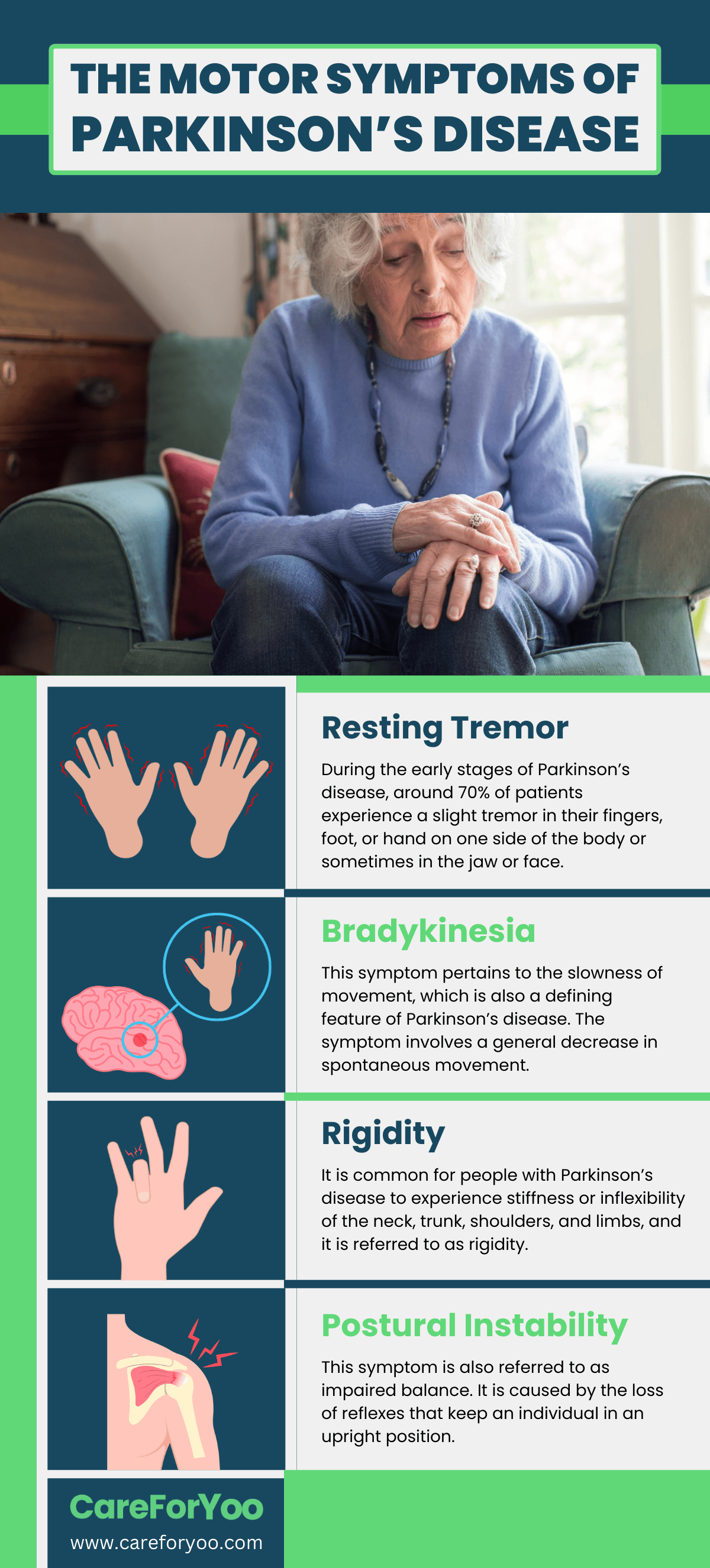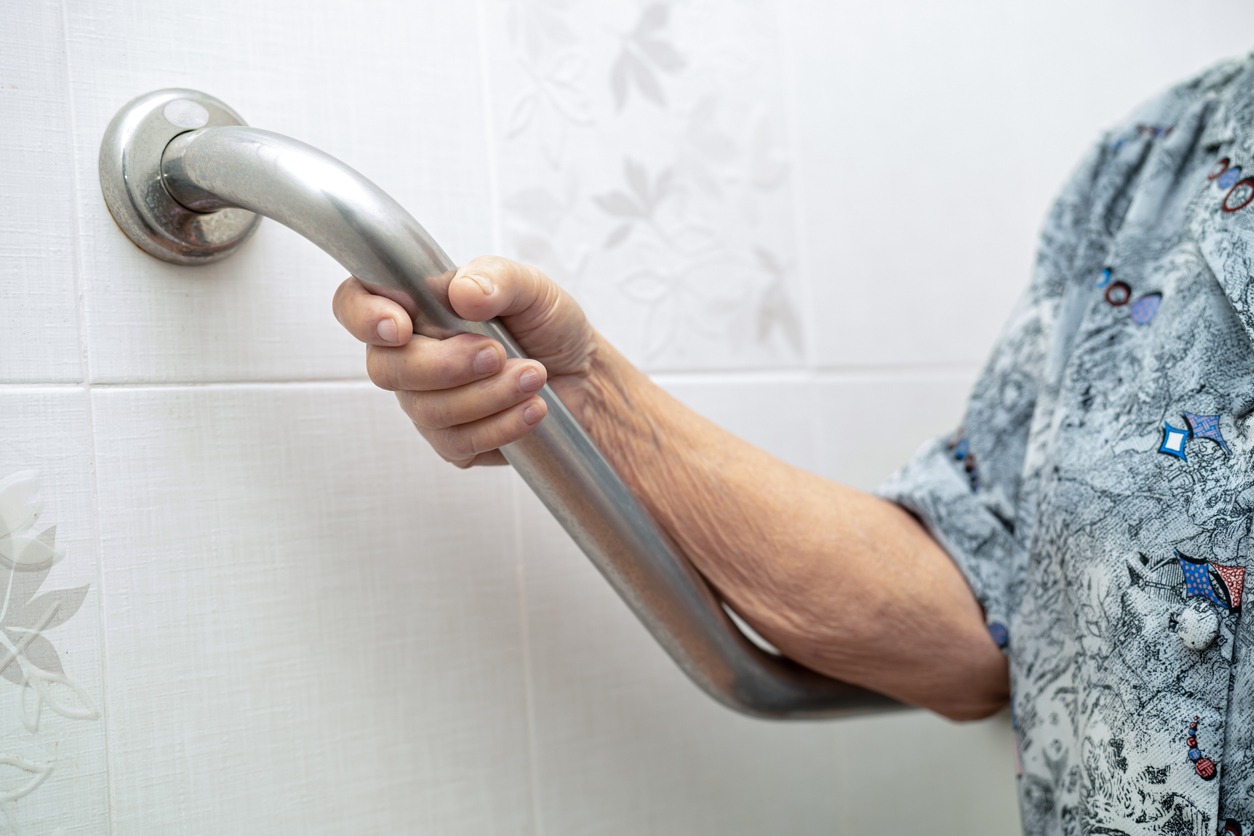Parkinson’s disease is a type of brain disorder that causes uncontrollable or unintentional movements, including shaking, difficulty with balance and coordination, and stiffness. The symptoms of Parkinson’s disease often start gradually and worsen over time. [1]
One of the most common symptoms of Parkinson’s disease is tremors, even when the muscles are at rest. This makes it difficult for people with the said disease to hold things properly. Aside from that, it may also affect their day-to-day activities, including eating, walking, working, doing chores, and more. While the condition is best known for how it affects an individual’s muscle control, movement, and balance, it may also cause a wide range of other effects on the senses, such as mental health, thinking ability, and more. [2]
As the condition progresses, the affected individual may have difficulty talking and walking. In addition to that, they may also experience mental and behavioral changes, such as depression, sleep problems, fatigue, and memory difficulties. [1] With this, some tasks may become more difficult for them. Luckily, there are now adaptive tools and assistive technology that are being introduced in the market for people with Parkinson’s disease.
Adaptive tools and assistive technology are innovative devices that are made to improve the daily living of people who have Parkinson’s disease. These tools may help enhance function and well-being and foster continued independence. There are now wide-ranging assistive devices that empower people experiencing Parkinson’s-related changes, supporting them in their homes and career. These tools are made to help them continue participating in the activities that bring them joy and the ones that keep them moving.
If you or someone you know is suffering from the symptoms of Parkinson’s disease and want to learn more about the devices that may help, you’re in the right place. In this post, we are giving you a guide to selecting assistive devices for people living with Parkinson’s disease.
The Motor Symptoms of Parkinson’s Disease
The motor symptoms of Parkinson’s disease pertain to the signs that affect the movement of the body. There are four main symptoms that are characteristic of the disease and are important for diagnosing the disorder. These include resting tremors, bradykinesia, rigidity, and postural instability. In addition to these, people who have Parkinson’s disease may also experience other motor symptoms, which include impaired coordination, freezing, and difficulty speaking. Also, since the condition is progressive, most of its symptoms begin slowly and then get worse over time. Read on below to learn more about the motor symptoms of Parkinson’s disease.
Resting Tremor
During the early stages of Parkinson’s disease, around 70% of patients experience a slight tremor in their fingers, foot, or hand on one side of the body or sometimes in the jaw or face. [3] The tremor entails a shaking or oscillating movement and usually occurs when the person’s muscles are relaxed or at rest. That is why it is called a “resting tremor.”
There are times when a hand tremor may be stopped by keeping the hand in motion or in a flexed grip. However, the tremor may get worse with excitement or stress, and it usually spreads to the other side of the body as it progresses. But most of the time, it remains ostensible on the initially affected side. [3]
Bradykinesia
This symptom pertains to the slowness of movement, which is also a defining feature of Parkinson’s disease. The symptom involves a general decrease in spontaneous movement. It can give the appearance of abnormal stillness and a reduction in facial expressiveness. [3]
Due to this symptom, an individual with Parkinson’s disease may have difficulties executing repetitive movements and doing daily tasks, such as brushing their teeth or buttoning their shirts. They may also walk with short, shuffling steps. In addition to that, the decrease in movement caused by bradykinesia may also affect a person’s speech as the condition worsens.
Rigidity
It is common for people with Parkinson’s disease to experience stiffness or inflexibility of the neck, trunk, shoulders, and limbs, and it is referred to as rigidity. This symptom causes the affected muscles to stay stiff and not relaxed. It decreases their range of motion, which can be uncomfortable and sometimes painful. People who experience rigidity and bradykinesia are unable to swing their arms while walking. [3]
Postural Instability
This symptom is also referred to as impaired balance. It is caused by the loss of reflexes that keep an individual in an upright position. There are some people with Parkinson’s disease who develop a dangerous tendency to sway backward when standing up from a chair or when turning. This issue is referred to as retropulsion, which may lead to a backward fall. The symptoms of postural instability often develop later on in the course of the disease. [3]
Types of Assistive Devices for People with Parkinson’s Disease
Medication organizers, an adaptive computer mouse, and hearing aids are all examples of assistive technology. These tools can help make the daily living tasks of people with Parkinson’s disease simple. Some tools are also engineered to ease the symptoms of the disease that affect speech, motor, balance, and thinking.
It is essential to allow enough time for tasks and create a safe home environment if you are living with Parkinson’s or caring for someone who does. Included in the many assistive devices to improve living with Parkinson’s are those that facilitate staying active, as exercise is vital for people living with the condition. [4]
To provide you with more ideas, below are the different types of assistive devices for people living with Parkinson’s disease, along with a few examples to help you choose:
Assistive Walking Aids
When people with Parkinson’s disease develop a shuffling gait or experience difficulty balancing, the use of canes or walkers may help in providing them additional stability when they walk. These tools may help enhance their safety, mobility, and balance.
When choosing walking aids, it is important to consider proper fitness. It’s because the height of the device needs to support a proper posture. For people with Parkinson’s disease, using straight canes may work better than a tripod or quad canes. If you are thinking of using a walker, it is better to choose a four-wheeled one as it offers better stability for people with Parkinson’s disease compared to those that need to be lifted. However, for those with late-stage Parkinson’s disease, an electric scooter or a wheelchair might be needed to get around safely and more effectively. [5]
Below are some examples of walking aids for Parkinson’s disease to help you choose:
Oasis Space Upright Walker: This is a pneumatic rubber upright walker that weighs 25 pounds. It is easy to lift and maneuver both indoors and outdoors. It also folds easily for easy transport and storage. It has 12-inch pneumatic rubber tires and 10-inch rear tires, which are perfect even when navigating grass, dirt, gravel, and gaps in sidewalks. It also comes with a seat and armrests for more comfortable use.
Carbon Ultralight Rollator by ACRE: This is an ultra-lightweight rollator that can be used both indoors and outdoors. It features a carbon fiber frame, which is five times stronger compared to steel. It can provide great strength, flexibility, and stability. It also features ergonomic reverse handles that provide a better posture while making it easy to maneuver around.
Assistive Eating Utensils
There are different companies that have developed eating utensils that make it easier for people who experience the tremor or shaking of Parkinson’s disease. There are some eating utensils that feature larger, weighted handles that are easier to grip. Some may also have sensor handles that neutralize the tremor and keep the utensil steady.
Some adaptive eating utensils may reduce shaking by around 70% and are best for patients with mild to moderate tremors. [5] Some knives cut with a rocking motion, which can make cutting food easier. There are also travel cups with lids and straws available, as well as plates with a scooped edge to prevent spills, which are all made for individuals living with Parkinson’s disease.
Below are some examples of eating utensils for people with Parkinson’s disease to help you pick:
BunMo Weighted Utensils for Parkinson’s Patients: These utensils look just like regular premium silverware. But they are specifically made for people who experience hand tremors. These are weighted silverware made for shaking hands. Each of them weighs around 7 ounces. The set includes a soup spoon, a fork, a knife, and a tablespoon.
GYENNO Parkinson Spoon: This is a steady spoon that electronically stabilizes so that the attached utensil shakes 85% less than the person’s hand. This way, you will worry less about spilling and focus more on enjoying your meals. It is portable tableware that has two parts, such as a stabilizing handle and a utensil attachment. It has an ergonomic design that adapts to the general hand-use habit. It is perfect for all kinds of meals.
High-Sided Scoop Plate by Liberty: This is a high-sided scoop plate that features an anti-slip, skid-proof base on the bottom of the plate to assist users as they eat. The high-side lip helps users by having them push the food up the lip of the plate onto their utensils. This plate is both microwave and dishwasher-safe. It is ideal for those who have trouble eating, especially those living with Parkinson’s disease.
Providence Spillproof Adult Sippy Cup: This is a carefully designed sippy cup for adults that helps reduce spills for those who experience hand tremors. It is easy to grip with its two ergonomic handles. It also has a wide base for added stability. The patient can drink from the spouted lid, or they may also insert a straw into the anti-splash lid. This cup can handle both warm and cold drinks. It can be used to prepare smoothies and soups, which is great for adults who are unable to eat solid foods.
Assistive Tools for Getting Dressed
Parkinson’s disease may also make getting dressed challenging, especially closing zippers, fastening buttons, and tying shoelaces. Luckily, there are various assistive devices out there that may help. One example is a weighted button aid. It features a heavy, large grip handle that makes pulling a button through a hole much easier.
There are also zipper pulls that attach a ring to the tiny handle on zippers. This makes them easier to grasp and zip up or down. Another example of an assistive tool for getting dressed is magnetic buttons. These create dress shirts with buttons on the outside and closed with magnets on the inside. Also, instead of tying shoelaces, patients with Parkinson’s disease may utilize shoes with Velcro. There are also elastic shoelaces that are much easier to fasten compared to traditional shoelaces. [5]
Below are some examples of assistive tools for getting dressed that may help people living with Parkinson’s disease:
RMS Button Hook with Zipper Pull: This tool is helpful for people with Parkinson’s disease as it can assist them with buttoning shirts and pulling zippers. It features a wide rubber handle that is easy to hold onto and maneuver. It also has a spring loop that can pull buttons through holes one-handedly, as well as a zipper aid. This helps people living with Parkinson’s disease get dressed without assistance.
Buttons 2 Button: Magnetic Button Adaptor Set: This magnetic button adaptor set will eliminate your frustration of buttoning and unbuttoning your shirts. It will allow you to close your shirt with a simple brush of a hand and open it with a gentle pull. It is perfect for people with limited dexterity and those with arthritic hands, Parkinson’s, neuropathy, and more. It makes buttoning an easy and pain-free process when getting dressed.
Assistive Bathroom Tools
There are a lot of assistive devices for people living with Parkinson’s disease that may help make the bathroom a safer and more manageable space for them. For example, handrails or bars can be installed in tubs and showers to make it safer for them to get in and out. There are also non-skid mats and decals that are great in reducing the risk of slipping.
In addition to those, you can also add tub chairs or benches if the bathroom is spacious enough. These are used by patients to sit in the tub safely and avoid slipping while taking a bath. The use of raised toilet seats or grab bars near the toilet is also ideal, and these may help patients to sit down and get up easily.
Grooming is another challenging task for people with Parkinson’s disease. But there are also assistive devices that may help them, such as electric toothbrushes and electric razors. Some bathrooms also have touch faucets that turn on the water with just a simple touch, as turning handles may become difficult for those with Parkinson’s disease. [5]
Below are a few examples of assistive bathroom tools for people living with Parkinson’s disease to help you choose:
Oasis Space Stand Alone Raised Toilet Seat: This is an elevated toilet seat that doubles as a stability frame. It is made with a corrosion-resistant aluminum frame. It is durable and can handle up to 300 pounds. It has a padded seat with soft rubber for superior support. It is very sturdy, making it easy to use for people with Parkinson’s disease.
Juvo Personal Wiping Aid: This self-assist toilet aid is great for people with a limited range of motion, such as those with Parkinson’s disease, obesity, and other issues. It has an integrated caddy tip that snaps over the tissue holder to keep things clean and sanitary. It can be used either from the front or back, depending on the condition. It has soft, rubberized jaws that hold toilet tissue in place for self-wiping. The trigger is easy to squeeze to release the tissue when done using.
Botabay Toilet Handrails: This handrail is made of space aluminum that is sturdy and durable. It can support up to 300 pounds of weight. It mounts to the wall to help the user keep his or her balance in the bathroom. It is designed for seniors, the disabled, and other mobility-impaired people to prevent them from slipping or falling.
Yoo.Mee ADA Handheld Shower Head for Parkinson’s: This showerhead can provide excellent showering care for the elderly and patients with Parkinson’s disease, arthritis, and the disabled. It has a unique extra-large silicone switching device that makes showering function adjustment more convenient. It has a comfortable grip handle that fully wraps on the handle stand. It has a soft water flow setting for warm showering care. It also has a special pause setting for convenient operation while showering.
Assistive Writing Devices
The motor symptoms of Parkinson’s disease can also make holding and using a writing instrument like pencils and pens difficult. Luckily, there are writing devices available that are easier to grip, such as pen holders that fit most round items, to make holding pens and writing easier. There are also other writing utensils out there that are designed to help improve shaky penmanship caused by Parkinson’s disease. [5] Below are some examples of assistive writing devices to help you pick:
Thixotropic HEAVY Super Big Fat Weighted Pen for Parkinson’s: This weighted pen can assist with the control of involuntary movements caused by the symptoms of Parkinson’s disease. It measures an inch across the pen grip. It is also helpful for other conditions that cause hand tremors.
Foam Grip Tubing: This foam padding can be used to hold pens and other items like toothbrushes, spoons, pencils, razors, and other tools. It is an ideal tool for people who have grip strength, control, or coordination issues. It can also be cut to length easily, depending on your intended use.
Assistive Organizing Tools
In some cases, Parkinson’s disease may also affect an individual’s memory. Therefore, if the patient is taking some medicines, it is also great if they can have a pillbox with compartments for organizing the medications and reminding them to take them. They may use the calendar function on a smartphone to alert them about certain appointments. The memo function, on the other hand, may be convenient for grocery and to-do lists. [6]
Below are some examples of assistive organizing tools for people living with Parkinson’s disease to help you pick:
TabTime Super 8 Electronic Pill Dispenser: This is an electronic pill dispenser that has 8 integrated alarms so that the patient will not miss another dose. This is uniquely designed for people with Parkinson’s, as the alarm fits right in the palm of the hand and works with you rather than against you. The opening mechanism of this pill dispenser is designed intelligently with a magnetic clasp so that your hand tremors can manage it easily. Once the box is opened, the alarm will stop immediately.
Betife Smart Automatic Pill Dispenser: This is an automatic pill reminder that features 28 compartments to help you organize your long-term pill doses and monitor different prescriptions, vitamins, and supplements. The reminder can be set up via Bluetooth using your smartphone. The pill box will notify you effortlessly if it is time to take your medicines, and it can be programmed to alarm up to six times a day. It also features a secure lockable cover to avoid accidental spills and to keep your medicines moisture-free.
TabTime Electronic Pill Timer: This pill timer can be set up to eight independent alarms that go off at the same time daily. It is pocket-sized, making it easy to bring anywhere. It is also very easy to set up. This timer will ensure that the patient with Parkinson’s disease will not forget to take his or her medicines on time.
Considerations When Choosing Assistive Devices for People with Parkinson’s Disease
When selecting assistive devices for people living with Parkinson’s disease, it is essential to keep in mind the specific symptoms and challenges that the individual is experiencing. To further help you, below are the considerations when choosing assistive devices for people with Parkinson’s disease:
Type and Severity of Symptoms
The first thing that you need to consider if you are looking for assistive devices for people with Parkinson’s disease is the type and severity of the symptoms they are experiencing. For example, most people with this condition usually experience tremors, which can make it hard for them to perform fine motor tasks like eating, writing, and holding objects. Therefore, if this is the case, they may benefit from assistive tools like weighted utensils, pen grips, and more that may help stabilize their hand and reduce tremors.
If the individual’s mobility and balance are affected by Parkinson’s disease, it can be difficult for them to stand or walk for extended periods. Therefore, assistive devices like walkers and canes can be helpful for them to maintain their mobility and independence. The same goes for their level of communication, cognitive impairment, and communication. That’s why before you buy an assistive device, you first need to make sure that it is clear what area they need help on.
Safety
Safety is a very important consideration when choosing assistive devices. You need to make sure that the device or tool is safe to use and should not pose any risks to the user or others around them.
Comfort
You also need to make sure that the assistive device is comfortable to use for long periods. It should not cause any pain or discomfort and should be made to fit the body or physical abilities of the individual.
Ease of Use
The assistive device should also be easy to use and operate. Choose those that do not need complex instructions or specialized training. They should be made to accommodate the physical abilities and limitations of the user.
Durability
The assistive device for people living with Parkinson’s disease should be durable and easy to maintain. Pick those that are made with materials that can withstand regular use and do not need frequent repairs or replacements.
Overall, when choosing assistive devices for people with Parkinson’s disease, it is very important to consider their specific needs and challenges, as well as their personal preferences. It is also best to consult with a healthcare professional or occupational therapist to ensure that your chosen assistive devices are right and effective for the patient.
Conclusion
Parkinson’s disease is a very common condition that affects many people as they get older. While it is not curable, there are a lot of ways that you can treat and manage the symptoms of this condition. These include various medications, therapies, and more. In order to cope with symptoms like tremors, using the assistive devices and tools that we’ve mentioned in this post might help. Most of them are commercially available through major retailers as well as online.
It is also important to reach out to your care team or doctor first before buying and using any medical-related equipment to ensure that it is safe and appropriate for you. We hope this post helped you learn more about selecting assistive devices for people living with Parkinson’s disease.
For more tips and recommendations, you may also read our Guide to Selecting Tools and Equipment for the Elderly with Hand Tremors.
References
[1] National Institute on Aging. (2022, April 14). Parkinson’s disease: Causes, symptoms, and treatments. National Institute on Aging. Retrieved March 13, 2023, from https://www.nia.nih.gov/health/parkinsons-disease
[2] Cleveland Clinic. (2022, April 15). Parkinson’s disease: What it is, causes, symptoms & treatment. Cleveland Clinic. Retrieved March 13, 2023, from https://my.clevelandclinic.org/health/diseases/8525-parkinsons-disease-an-overview
[3] Parkinson’s News Today. (2022, June 22). Motor symptoms of Parkinson’s disease. Parkinson’s News Today. Retrieved March 13, 2023, from https://parkinsonsnewstoday.com/parkinsons-disease-symptoms/motor/
[4] Parkinson’s Foundation. (n.d.). Assistive Technology & Devices. Parkinson’s Foundation. Retrieved March 13, 2023, from https://www.parkinson.org/living-with-parkinsons/management/activities-daily-living/assistive-tech-devices
[5] HU Medical Review Board (Ed.). (2017, March 4). Assistive devices for Parkinson’s disease. ParkinsonsDisease.net. Retrieved March 13, 2023, from https://parkinsonsdisease.net/living-with-pd/assistive-devices
[6] Andrews, L. W. (2021, August 17). 10 types of assistive devices for Parkinson’s disease. Healthgrades. Retrieved March 13, 2023, from https://www.healthgrades.com/right-care/parkinsons-disease/10-types-of-assistive-devices-for-parkinsons-disease












